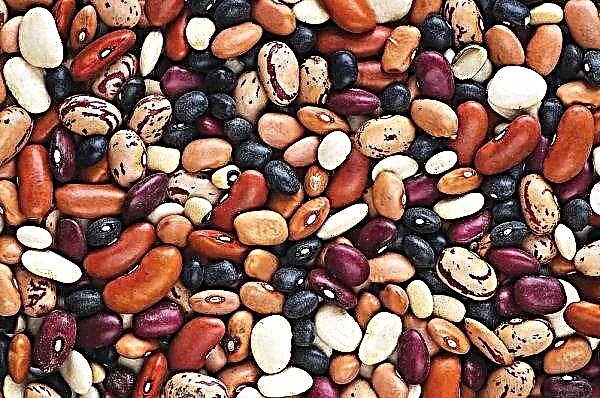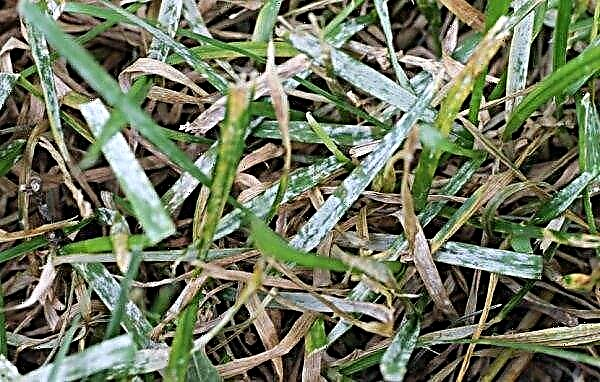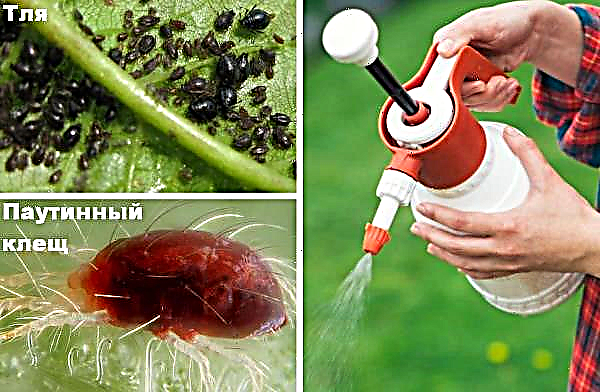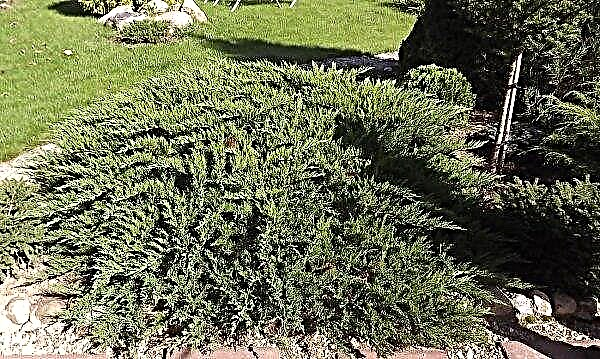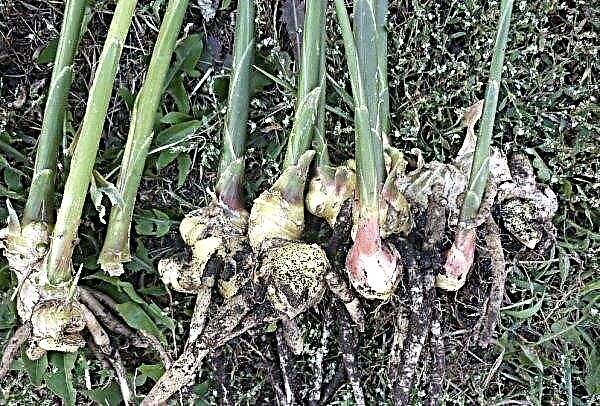Most tomato varieties grown on farms need a warm climate and plenty of sunlight. Specially for regions with cool summers, tomato varieties unpretentious to growing conditions were developed, one of which is the Martha F1 variety. Further in the article, we will consider the main characteristics of this variety, the features of growing and the subtleties of caring for plants, as well as methods of combating diseases and pests.
Characterization and description of the variety
Tomato Marfa F1 is a hybrid and was bred at the end of the twentieth century for cultivation in the central and northern regions with a cool climate. The breeders of the Dutch agricultural company Royal Sluis worked on the creation of the variety. As a result of their work, they received a new high-yielding tomato variety, which was distinguished by its unpretentiousness to growing conditions and excellent characteristics of ripe fruits.
Did you know? Tomato is the official vegetable of the US state of New Jersey, and its juice is recognized as the official drink of the state of Ohio.
Consider the main characteristics of this variety:
- Marfa F1 tomato bushes are indeterminate, can grow to a height of 1.7 m. The lateral branches of the plant are moderately sprawling.
- The root system of the plant is powerful and well developed.
- The leaves of the bush are medium in size, painted in dark green. Crohn's plants are not too voluminous.
- Inflorescences are simple, formed every 3-4 leaves. The first inflorescence is formed after the appearance of 7-8 leaves on the plant.
- The variety has late ripening, tomato harvest can be harvested 4 months after the appearance of green shoots.
- Tomatoes grow with brushes, 6-8 each. on each. The mass of one fruit is about 140 g.
- The variety belongs to the high-yielding. From one bush you can collect up to 7 kg of ripe fruits.
- Tomatoes have a round, slightly flattened shape and medium size.
- The peel of ripe fruits is even and dense, has a dark red color and a characteristic glossy shine.
- The pulp of tomatoes has a moderate density, fleshy and very juicy. The number of seeds is small.
- The fruits have a sweet, rich taste. They can be transported over long distances and retain freshness for a long time.
- Plants are resistant to many common diseases and can withstand sudden changes in temperature.
Video: Tomato varieties Marfa
Pros and cons of the variety
Tomatoes of this variety can be grown both on an industrial scale and in small farms due to the large number of positive qualities.
- The pluses of Marfa F1 include:
- high productivity;
- unpretentiousness in leaving;
- great taste of tomatoes;
- beautiful presentation;
- resistance to adverse climatic conditions;
- high transportability of tomatoes;
- good keeping quality of fresh fruits;
- immunity to diseases;
- the versatility of using tomatoes.
- The disadvantages of Marfa F1 include:
- mandatory formation of tall and fluffy bushes of tomatoes;
- the need to tie plants.
The optimal timing for growing tomato Marfa F1
Sowing tomato seeds Marfa F1 for growing seedlings is recommended to begin in the second half of March. In this case, the seedlings will be ready for transplanting to a permanent place of cultivation in the second half of May. Earlier sowing of seeds for seedlings is not recommended, as overgrown young plants tolerate transplanting worse.
Important! If you plan to grow Marfa F1 tomatoes in a greenhouse, then you can sow seeds for seedlings a little earlier - in the first half of March.
The basic rules of growing
This variety can be grown in open ground, but only in regions with a moderately warm climate. In conditions of cool summers and lack of sunlight, it is recommended to grow plants in a greenhouse to avoid loss of yield.
Even in the absence of experience, you can successfully grow Marfa F1 tomatoes and get a good harvest. But if you follow the few rules and recommendations described below, then the yield of plants increases several times. Let us consider in more detail the main features of the cultivation of tomatoes Marfa F1.

Growing seedlings
The process of growing tomatoes Marfa F1 begins with the proper planting of seeds and care of seedlings.
The seeds of this variety are distinguished by good germination, but for the best result it is recommended to carry out several additional steps for their preparation:
- warm the seeds on the battery for several days by placing them in a small cloth bag;
- disinfect the seeds with a weak potassium permanganate solution;
- treat planting material with growth stimulants (for example, Epin);
- dry the seeds a little at room temperature before planting.
You can use a ready-made store substrate or prepare the soil yourself from the following components:
- turf land;
- garden land;
- humus;
- river sand.

Consider the step-by-step instructions for planting seeds and the rules for growing tomato seedlings:
- Make small holes in the soil surface with a depth of about 1-1.5 cm.
- Submerge the tomato seeds in the prepared cavities and sprinkle with a small layer of peat.
- Lightly spray the soil with seeds with warm water and cover with a film. Keep the container in a room with a temperature of about +25 ° C.
- After the seeds give green shoots, remove the film. Put the seedlings in a well-lit place with an air temperature of about + 16 ° C for about 1 week. Then increase the air temperature in the room with seedlings to + 22 ° C.
- When a couple of green leaves appear on the seedlings, pick a seedling. Add complex liquid fertilizer.
- As the top layer of the earth dries, carry out moderate watering of the sprouts with warm water from the watering can. Grow seedlings away from drafts.
Did you know? The leader in growing tomatoes is China. It produces about 16% of the total number of tomatoes in the world.
Preparation of soil for planting seedlings
Tomatoes are not recommended to be planted for two years in a row in the same place - this will lead to soil depletion and reduced yield. The plot for growing plants needs to be changed every year. And in order for the seedlings to work well on the site and give a high yield, the soil must be prepared beforehand.
This procedure consists of several stages:
- dig the soil in the fall, and then pour it with a warm aqueous solution of copper sulfate (10 tbsp of water requires 1 tbsp. of substance);
- in the spring, add organic fertilizer consisting of peat, humus and sawdust with the addition of superphosphate;
- 10 days before planting seedlings, again dig the site and treat the ground with a solution of lime;
- To disinfect the soil, pour it with a hot solution of potassium permanganate.

Seedling Planting Technology
Planting young seedlings of tomatoes in a greenhouse is usually carried out when the sprouts reach the age of 60-65 days. At this time, 3-4 pairs of green leaves and at least one flower brush have already been formed on the plants. Planting seedlings in open ground is carried out a little later and only after the soil has warmed enough.
Step-by-step instructions for transplanting seedlings are presented below:
- Dig holes in the soil about 8 cm deep. Put nitrogen fertilizers on the bottom of the recess.
- Carefully remove the young sprout from the individual container along with an earthen lump.
- Place the seedling in the hole and sprinkle its roots with earth. Lightly tamp the soil around the stem of the sprout.
- If the soil is not wet enough, you can water the seedling under the root with a small amount of warm water.
Important! Planting seedlings is carried out according to the scheme 50x40, no more than 3 plants can be placed on 1 m².
Variety Care Features
Variety of tomatoes Marfa F1 is not picky in care, but with proper watering, tillage and regular feeding, plant productivity is significantly increased. Consider the main recommendations for the care of tomato bushes.
Fertilizers and watering
For normal growth, plants need nutrients, so during the season you need to feed tomato bushes with fertilizers 3-4 times.
You need to add dressing according to the following rules:
- to increase productivity 1-2 times per season, fertilizers containing magnesium are applied;
- after the formation of the ovaries make top dressing from potassium and phosphorus;
- at the stage of fruit ripening, complex mineral fertilizers are introduced.
After planting tomatoes in a permanent place you need to carry out regular moderate watering of plants.
The basic rules for watering the bushes are listed below:
- water the tomatoes under the root;
- you can use only warm water;
- tomatoes need to be watered every 3 days so that the soil around them does not dry out;
- the procedure is carried out in the evening after sunset to avoid rapid evaporation of water;
- You can not oversaturate the soil with moisture so that the tomatoes do not drop the formed ovaries.
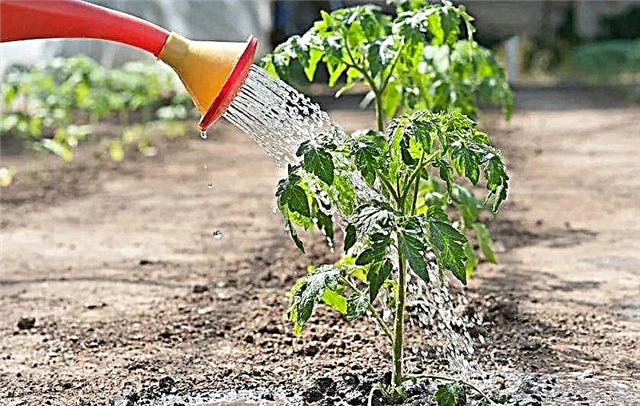
Pasynkovka and formation of a bush
To uniformly ripen the fruit and improve access to sunlight, the Marfa F1 tomato bushes need to be formed. For the first time, this procedure is recommended to be carried out immediately after transplanting seedlings to a permanent place. Typically, plants grow in 1 stalk, cutting off all excess side shoots.
The basic rules for the formation of a bush of tomatoes Marfa F1 are listed below:
- when the main stem of the plant begins to divide into 2-3 parts, then leave the strongest of them, and cut off the rest;
- all stepsons formed in the axils of the leaves are cut so that only a small “stump” of 2-3 cm in length remains;
- after 5-6 brushes are formed on the main stem, pinch the top of the plant, leaving at least 2-3 leaves above the last brush;
- yellowed leaves and stepsons growing below the level of the first brush also need to be trimmed;
- You cannot remove more than 2-3 leaves at a time.
Marfa F1 tomatoes also need a garter. Stable supports are placed near the plants, to which branches with tomatoes are tied with twine or twine. It is recommended to carry out this procedure even at the stage of fruit formation, so that fragile branches do not break under the weight of tomatoes and the bush does not fall on its side.Did you know? Green tomatoes contain a strong poison - solanine. Eating 2 kg of green tomatoes leads to serious poisoning.
Soil cultivation and weeding
After transplanting tomato seedlings Marfa F1 to a permanent place, you need to monitor the condition of the soil around the plants. Mandatory procedures are regular removal of weeds and loosening of the earth around the bushes, they must be performed every 7-10 days.
- This will increase the yield of the variety, as weeding and loosening the soil provide several advantages:
- do not allow growing weeds to obscure young seedlings of tomatoes;
- contribute to the preservation in the soil of nutrients and moisture required for tomato bushes;
- prevent the occurrence of common plant diseases;
- improve soil breathability and facilitate water access to the roots of the bushes.
Diseases and pests
Marfa F1 tomatoes have a strong immunity to tobacco mosaic, cladosporiosis, fusarium, gall nematode. Under the condition of preventive treatment of seeds and soil before planting, the listed diseases are not terrible for plants. Planted seedlings can also be treated with Phytosporin to prevent the development of fungal diseases. Marfa F1 tomato bushes can be attacked by insects.
Consider the main signs of plant infection and pest control methods:
- Aphid. Insects are placed on the lower surface of the leaves, sucking out juices from them and leaving behind a sticky liquid. Damaged leaves begin to dry up, and unripe fruits located under them are deformed and do not ripen. Aphid not only leads to the death of the green mass of the bush, but can also spread a fungal infection. To destroy the pest, tomato leaves are washed with a warm soapy solution. With a large number of insects, insecticides are used, spraying them with plants.

- Whitefly. This insect lays eggs on the lower surface of the leaf, from which small white larvae hatch. They suck out all the juices from the leaves and secrete an enzyme that covers the plant with a thin layer and contains spores of a harmful fungus. As a result of infection, leaves with yellow or black spots appear on the bush, the green mass begins to wither, and the tomatoes do not ripen. You can get rid of insects using an aqueous solution of celandine. If there are a lot of pests, then insecticides are used.

- Slug. Pests can eat not only the green mass of the bush, but also tomatoes. Signs of their appearance are large through holes in the leaves and fruits, as well as the presence of silvery mucus on the plant. The affected bush stops growing, the inflorescences fall off, and the fruits begin to rot. Sick plants are treated with an aqueous solution of ammonia. With a large number of slugs, chemical poisons are used, which include metaldehyde.
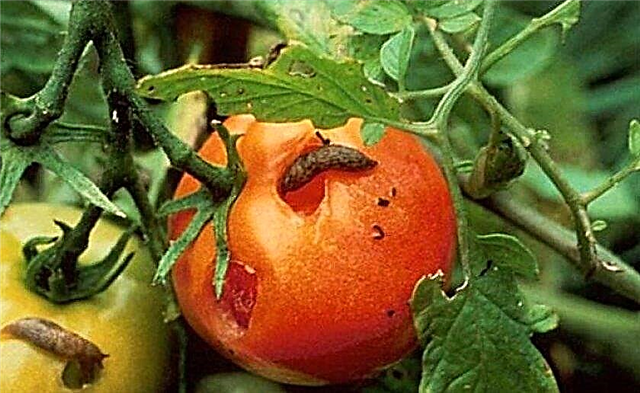
To prevent the appearance of pests on tomatoes, you need to perform such actions:
- regularly inspect plants for insects;
- thoroughly remove last year’s weeds;
- when growing in a greenhouse, carry out regular ventilation of the structure in order to prevent stagnation of air and high humidity;
- place garlic, thyme or lavender planting next to tomatoes - their smell repels insects well;
- adhere to the recommended planting scheme, observing the indicated distances between the bushes;
- Do not abuse watering;
- carry out regular loosening of soil around the bushes.
Important! When spraying tomato bushes with insecticides, chemicals must not be allowed to enter the fruit, as they will make the tomatoes unfit for food.
Harvesting and storage rules
Harvest ripe tomatoes can be harvested from mid-July until the first autumn frosts. Fruits are resistant to mechanical damage, but cannot be subjected to impact or deformation during harvesting.

For storage, only ripe and dense fruits are selected that have no damage and dents on the peel. Marfa F1 tomatoes have a good shelf life and can be stored for up to 35 days in a cool and dark place.







